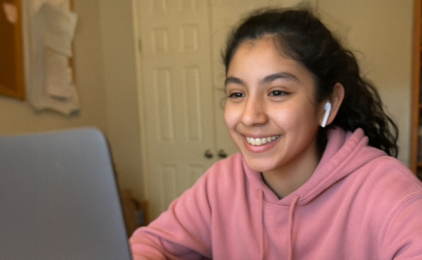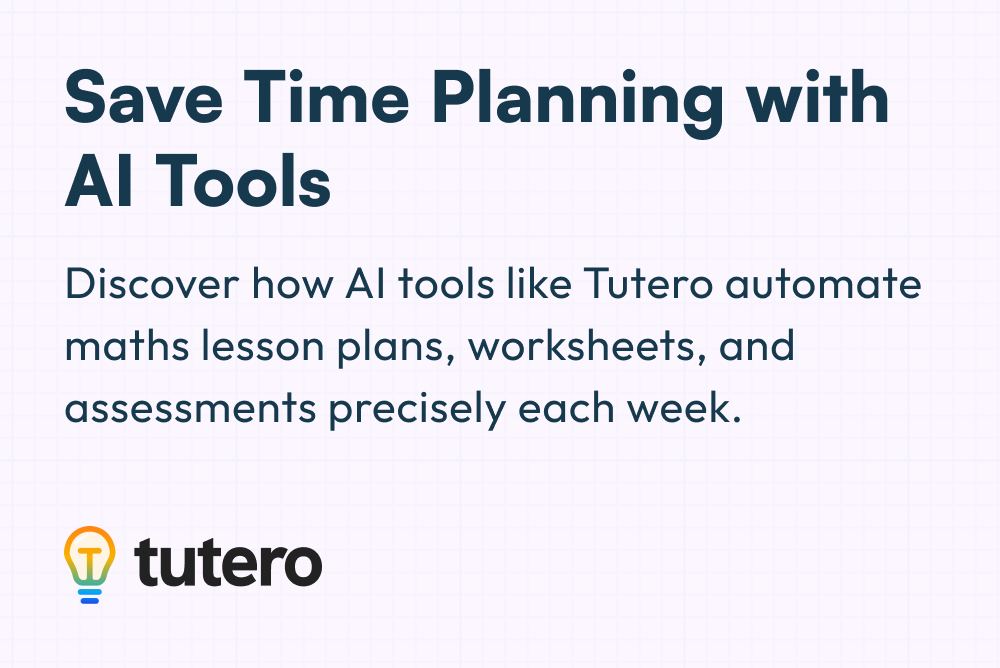AI in education is reshaping teaching faster than any previous innovation. For maths teachers, it is both a breakthrough and a profound disruption. Unlike earlier tools, this change affects the very structure of learning itself. How do we ensure students develop foundational critical thinking skills when a sophisticated AI-powered maths problem solver delivers instant answers?
This is not a conversation about if AI will reshape maths education. It already has. The core focus must now be on intention and pedagogy. We need a framework to move forward. The most important framing line for any educator right now is this: Educators must become both AI-aware and AI-enhanced. That is the thesis. We need to know how math teachers use AI in their classroom as a powerful partner, not a passive spectator.

Why AI Literacy is the New Digital Literacy
Why the urgency? History shows that technological adoption follows a predictable curve. We are still standing at the very beginning of the AI curve. Twenty years ago, early adopters of digital tools gained a long-term professional advantage. The same principle applies to AI literacy today.
The new reality is simple: AI literacy will quickly become as fundamental as digital literacy was two decades ago. The early, thoughtful adoption of AI tools for maths teachers is not just about being trendy. It is about gaining the teaching boost that allows you to achieve the long-standing goal of delivering personalizing learning for every student. Knowing how math teachers use AI in their classroom is essential professional development for the next decade. If you do, you unlock real efficiency with AI that saves hours every week. Plus, it frees you to focus on the essential human skills of teaching.

Balancing the Benefits and the Challenges
AI offers a great opportunity. It can save teachers hours and deepen student engagement—but without careful design, it can weaken reasoning, invite shortcuts, or widen inequities. We must actively mitigate these risks.
First is Over-Reliance—the dependency that weakens reasoning. Maths is all about the process, the struggle, and the development of reasoning. If an AI-powered maths problem solver removes the process, we have failed. We must design tasks that force students to critique the AI’s output.
Second is Cheating and Fair Assessment. Unchecked use of tools like ChatGPT undeniably undermines fair assessment, especially for standard computational problems. The answer is not banning the tool. It is reinventing assessment.
Third is Equity of Access. If we rely on high-end, proprietary AI tools for math teachers, we risk widening the digital divide. Our adoption strategies must prioritize platforms that are accessible and provided equitably. This demands a serious discussion about the ethical use of AI in schools. We must address these risks proactively, not reactively.

The Framework: When, What, How to Use AI in Maths
To move beyond the fear and the buzzwords, we must introduce a practical framework for integrating AI into curriculum. We can simplify our approach by focusing on three key questions: WHEN, WHAT, and HOW.
1. When Can We Use AI?
AI is best deployed in three critical areas where teacher time is wasted, or student need is greatest. This application enhances student engagement and AI and provides instant, useful information for instruction:
- Planning: Lesson plans, quizzes, and differentiated materials, using AI lesson planning tools.
- Assessment: Diagnostic quizzes, formative check-ins, and generating targeted AI for formative assessment.
- Engagement: Creating real-life contexts, visual explanations, and exploratory prompts.
2. What Tools Should Teachers Use?
This is a crucial choice. Generic AI tools, like ChatGPT, are widely available and useful. However, they are built for text, not for teaching maths. Specialized platforms are built for pedagogy.
Generic AI: Using ChatGPT in Education
ChatGPT is a powerful, general-purpose tool. It is useful for generating word problems, writing letters to parents, or drafting rubrics—excelling in open-ended text generation, creative analogies, and initial drafts. But, It often struggles with precise maths syntax, lacks visual representation, and requires advanced prompting skills to get quality, pedagogically sound content.
Specialized AI: Tutero Schools
Specialized platforms are the subject-aligned solution. Tutero Schools, for example, is dedicated to AI in maths education. It is purpose-built to be curriculum-aligned, visual, and automatically differentiated.
Key Benefit for Maths Teachers
This specialised platform generates structured, scaffolded visuals, diagnostic reports, and adaptive learning platforms without manual prompt tuning. It is best for core instructional material because it understands the how and why of maths pedagogy. This is the difference between a general-purpose screwdriver and a torque wrench designed specifically for your engine.
The Four Core Strategies for the AI-Enhanced Math Classroom
The real question remains the HOW. These four core strategies transition AI from a concept to a daily practice. They are the practical answers to how math teachers use AI in their classroom.
Strategy 1: Turbo-Charging Lesson Planning and Differentiation
Goal: Speed up unit preparation and deliver effective differentiation at scale.
This is where AI lesson planning tools deliver the most visible impact.
Example: Your prompt becomes:
“Generate a 7th-grade Common Core lesson plan on probability, including a real-life context example, an exit ticket, and an investigation task for early finishers.”
Tutero Advantage: Specialized platforms move past the structural skeleton. They automatically build differentiated, curriculum-aligned lesson plans, including integrated visuals and resources linked to specific student weaknesses tracked by AI learning analytics. This is how you get truly personalized learning.

Pitfall to Avoid: Complacency. Always use the AI output as a draft. Review every problem for accuracy, cultural relevance, and clarity.
Strategy 2: Creating Tiered Worksheets and Scaffolds
Goal: Instant creation of tiered, scaffolded exercises.
Differentiation is impossible without tiered resources. Adaptive learning platforms manage this process seamlessly.
Example: You need a challenge. You prompt a generic tool:
"Create a worksheet for Algebra I on rational expressions with step-by-step hints and an extension on domain restrictions."
Tutero Advantage: A specialized platform focuses on creating structured, scaffolded visuals. It links the new worksheet directly to the students flagged by AI for formative assessment as needing extra support. This feels like built-in adaptive tutoring within your own lesson ecosystem.

Strategy 3: Anchoring Abstract Math in Real-Life Contexts
Goal: Anchor abstract maths in relevant, real-life context.
Example: You are teaching parabolas. Prompt a tool: "Show how quadratic equations apply in three distinct sports or architectural examples that 10th graders would find relevant." This instantly generates fresh, unique contexts that boost student engagement and AI levels.
The key here is using AI to create the context or the analogy, not just the solution. This encourages a deeper, conceptual understanding, which is the heart of effective AI teaching strategies. The AI saves you the research time needed to find compelling examples, supporting data-driven instruction.
Strategy 4: Designing Homework for an AI World
Goal: Design homework to assess reasoning, not just answers.
The most critical strategy is addressing academic integrity. Since students will inevitably have access to AI-powered maths problem solvers, we must reinvent homework.
Strategy: Design homework around inquiry and metacognition. Ask students to:
- "Write a process journal detailing the steps you took to solve this multi-step linear programming problem."
- "Use an AI tool for maths teachers to solve this problem, but then identify where the AI solution is insufficient and explain the conceptual mistake it made."
This is the practical implementation of ethical use of AI in schools. It shifts your focus to evaluating high-quality, conceptual work, not just tallying right and wrong answers, which is effectively automating grading with AI for the rote parts, leaving you the deep analysis.
Starting Small, Staying Ethical
The shift toward integrating AI into curriculum does not need to be a massive, overwhelming project. Start small. Focus on incremental change.
- Start small. Apply one AI strategy in a single unit - perhaps a formative assessment tool—and observe its impact. Always treat AI outputs as drafts, reviewing for accuracy and clarity before use.
- Model Ethical Use: Talk openly with your students about the technology. Discuss prompt design and evaluation as a crucial digital literacy skill. Show them how you use an AI tool to save time so you can spend more time conferencing with them.
- Collaborate: Talk to the teacher next door. Share your tested workflows. You will discover that collective AI teaching strategies accelerate adoption and improve quality far faster than working alone.

The AI-Ready Educator: Amplifying the Human Core
The verdict is in. AI in maths education is the most powerful tool for teachers since the adoption of the personal computer. It handles the busy work. It delivers personalized learning to many students. It provides instant information about student learning that drives your decision-making.
AI will not replace the teacher. It will amplify the best teachers. It cannot replicate your enthusiasm when a student finally understands a difficult concept. It cannot provide the classroom management finesse. It cannot offer the empathy, creativity, or judgment required to guide a young person through adolescence and algebra simultaneously.
By integrating AI intelligently, you’re not delegating your work—you’re protecting it. You are freeing yourself from the drudgery to be the creative, empathetic, and conceptual guide your students need and deserve.
Explore how Tutero Schools helps you create aligned, differentiated math lessons in minutes. Visit schools.tutero.com to learn more.
AI in education is reshaping teaching faster than any previous innovation. For maths teachers, it is both a breakthrough and a profound disruption. Unlike earlier tools, this change affects the very structure of learning itself. How do we ensure students develop foundational critical thinking skills when a sophisticated AI-powered maths problem solver delivers instant answers?
This is not a conversation about if AI will reshape maths education. It already has. The core focus must now be on intention and pedagogy. We need a framework to move forward. The most important framing line for any educator right now is this: Educators must become both AI-aware and AI-enhanced. That is the thesis. We need to know how math teachers use AI in their classroom as a powerful partner, not a passive spectator.

Why AI Literacy is the New Digital Literacy
Why the urgency? History shows that technological adoption follows a predictable curve. We are still standing at the very beginning of the AI curve. Twenty years ago, early adopters of digital tools gained a long-term professional advantage. The same principle applies to AI literacy today.
The new reality is simple: AI literacy will quickly become as fundamental as digital literacy was two decades ago. The early, thoughtful adoption of AI tools for maths teachers is not just about being trendy. It is about gaining the teaching boost that allows you to achieve the long-standing goal of delivering personalizing learning for every student. Knowing how math teachers use AI in their classroom is essential professional development for the next decade. If you do, you unlock real efficiency with AI that saves hours every week. Plus, it frees you to focus on the essential human skills of teaching.

Balancing the Benefits and the Challenges
AI offers a great opportunity. It can save teachers hours and deepen student engagement—but without careful design, it can weaken reasoning, invite shortcuts, or widen inequities. We must actively mitigate these risks.
First is Over-Reliance—the dependency that weakens reasoning. Maths is all about the process, the struggle, and the development of reasoning. If an AI-powered maths problem solver removes the process, we have failed. We must design tasks that force students to critique the AI’s output.
Second is Cheating and Fair Assessment. Unchecked use of tools like ChatGPT undeniably undermines fair assessment, especially for standard computational problems. The answer is not banning the tool. It is reinventing assessment.
Third is Equity of Access. If we rely on high-end, proprietary AI tools for math teachers, we risk widening the digital divide. Our adoption strategies must prioritize platforms that are accessible and provided equitably. This demands a serious discussion about the ethical use of AI in schools. We must address these risks proactively, not reactively.

The Framework: When, What, How to Use AI in Maths
To move beyond the fear and the buzzwords, we must introduce a practical framework for integrating AI into curriculum. We can simplify our approach by focusing on three key questions: WHEN, WHAT, and HOW.
1. When Can We Use AI?
AI is best deployed in three critical areas where teacher time is wasted, or student need is greatest. This application enhances student engagement and AI and provides instant, useful information for instruction:
- Planning: Lesson plans, quizzes, and differentiated materials, using AI lesson planning tools.
- Assessment: Diagnostic quizzes, formative check-ins, and generating targeted AI for formative assessment.
- Engagement: Creating real-life contexts, visual explanations, and exploratory prompts.
2. What Tools Should Teachers Use?
This is a crucial choice. Generic AI tools, like ChatGPT, are widely available and useful. However, they are built for text, not for teaching maths. Specialized platforms are built for pedagogy.
Generic AI: Using ChatGPT in Education
ChatGPT is a powerful, general-purpose tool. It is useful for generating word problems, writing letters to parents, or drafting rubrics—excelling in open-ended text generation, creative analogies, and initial drafts. But, It often struggles with precise maths syntax, lacks visual representation, and requires advanced prompting skills to get quality, pedagogically sound content.
Specialized AI: Tutero Schools
Specialized platforms are the subject-aligned solution. Tutero Schools, for example, is dedicated to AI in maths education. It is purpose-built to be curriculum-aligned, visual, and automatically differentiated.
Key Benefit for Maths Teachers
This specialised platform generates structured, scaffolded visuals, diagnostic reports, and adaptive learning platforms without manual prompt tuning. It is best for core instructional material because it understands the how and why of maths pedagogy. This is the difference between a general-purpose screwdriver and a torque wrench designed specifically for your engine.
The Four Core Strategies for the AI-Enhanced Math Classroom
The real question remains the HOW. These four core strategies transition AI from a concept to a daily practice. They are the practical answers to how math teachers use AI in their classroom.
Strategy 1: Turbo-Charging Lesson Planning and Differentiation
Goal: Speed up unit preparation and deliver effective differentiation at scale.
This is where AI lesson planning tools deliver the most visible impact.
Example: Your prompt becomes:
“Generate a 7th-grade Common Core lesson plan on probability, including a real-life context example, an exit ticket, and an investigation task for early finishers.”
Tutero Advantage: Specialized platforms move past the structural skeleton. They automatically build differentiated, curriculum-aligned lesson plans, including integrated visuals and resources linked to specific student weaknesses tracked by AI learning analytics. This is how you get truly personalized learning.

Pitfall to Avoid: Complacency. Always use the AI output as a draft. Review every problem for accuracy, cultural relevance, and clarity.
Strategy 2: Creating Tiered Worksheets and Scaffolds
Goal: Instant creation of tiered, scaffolded exercises.
Differentiation is impossible without tiered resources. Adaptive learning platforms manage this process seamlessly.
Example: You need a challenge. You prompt a generic tool:
"Create a worksheet for Algebra I on rational expressions with step-by-step hints and an extension on domain restrictions."
Tutero Advantage: A specialized platform focuses on creating structured, scaffolded visuals. It links the new worksheet directly to the students flagged by AI for formative assessment as needing extra support. This feels like built-in adaptive tutoring within your own lesson ecosystem.

Strategy 3: Anchoring Abstract Math in Real-Life Contexts
Goal: Anchor abstract maths in relevant, real-life context.
Example: You are teaching parabolas. Prompt a tool: "Show how quadratic equations apply in three distinct sports or architectural examples that 10th graders would find relevant." This instantly generates fresh, unique contexts that boost student engagement and AI levels.
The key here is using AI to create the context or the analogy, not just the solution. This encourages a deeper, conceptual understanding, which is the heart of effective AI teaching strategies. The AI saves you the research time needed to find compelling examples, supporting data-driven instruction.
Strategy 4: Designing Homework for an AI World
Goal: Design homework to assess reasoning, not just answers.
The most critical strategy is addressing academic integrity. Since students will inevitably have access to AI-powered maths problem solvers, we must reinvent homework.
Strategy: Design homework around inquiry and metacognition. Ask students to:
- "Write a process journal detailing the steps you took to solve this multi-step linear programming problem."
- "Use an AI tool for maths teachers to solve this problem, but then identify where the AI solution is insufficient and explain the conceptual mistake it made."
This is the practical implementation of ethical use of AI in schools. It shifts your focus to evaluating high-quality, conceptual work, not just tallying right and wrong answers, which is effectively automating grading with AI for the rote parts, leaving you the deep analysis.
Starting Small, Staying Ethical
The shift toward integrating AI into curriculum does not need to be a massive, overwhelming project. Start small. Focus on incremental change.
- Start small. Apply one AI strategy in a single unit - perhaps a formative assessment tool—and observe its impact. Always treat AI outputs as drafts, reviewing for accuracy and clarity before use.
- Model Ethical Use: Talk openly with your students about the technology. Discuss prompt design and evaluation as a crucial digital literacy skill. Show them how you use an AI tool to save time so you can spend more time conferencing with them.
- Collaborate: Talk to the teacher next door. Share your tested workflows. You will discover that collective AI teaching strategies accelerate adoption and improve quality far faster than working alone.

The AI-Ready Educator: Amplifying the Human Core
The verdict is in. AI in maths education is the most powerful tool for teachers since the adoption of the personal computer. It handles the busy work. It delivers personalized learning to many students. It provides instant information about student learning that drives your decision-making.
AI will not replace the teacher. It will amplify the best teachers. It cannot replicate your enthusiasm when a student finally understands a difficult concept. It cannot provide the classroom management finesse. It cannot offer the empathy, creativity, or judgment required to guide a young person through adolescence and algebra simultaneously.
By integrating AI intelligently, you’re not delegating your work—you’re protecting it. You are freeing yourself from the drudgery to be the creative, empathetic, and conceptual guide your students need and deserve.
Explore how Tutero Schools helps you create aligned, differentiated math lessons in minutes. Visit schools.tutero.com to learn more.
FAQ
.svg)
.svg)
Online maths tutoring at Tutero is catering to students of all year levels. We offer programs tailored to the unique learning curves of each age group.
.svg)
.svg)
We also have expert NAPLAN and ATAR subject tutors, ensuring students are well-equipped for these pivotal assessments.
.svg)
.svg)
We recommend at least two to three session per week for consistent progress. However, this can vary based on your child's needs and goals.
.svg)
.svg)
Our platform uses advanced security protocols to ensure the safety and privacy of all our online sessions.
.svg)
.svg)
Parents are welcome to observe sessions. We believe in a collaborative approach to education.
.svg)
.svg)
We provide regular progress reports and assessments to track your child’s academic development.
.svg)
.svg)
Yes, we prioritise the student-tutor relationship and can arrange a change if the need arises.
.svg)
.svg)
Yes, we offer a range of resources and materials, including interactive exercises and practice worksheets.
AI in education is reshaping teaching faster than any previous innovation. For maths teachers, it is both a breakthrough and a profound disruption. Unlike earlier tools, this change affects the very structure of learning itself. How do we ensure students develop foundational critical thinking skills when a sophisticated AI-powered maths problem solver delivers instant answers?
This is not a conversation about if AI will reshape maths education. It already has. The core focus must now be on intention and pedagogy. We need a framework to move forward. The most important framing line for any educator right now is this: Educators must become both AI-aware and AI-enhanced. That is the thesis. We need to know how math teachers use AI in their classroom as a powerful partner, not a passive spectator.

Why AI Literacy is the New Digital Literacy
Why the urgency? History shows that technological adoption follows a predictable curve. We are still standing at the very beginning of the AI curve. Twenty years ago, early adopters of digital tools gained a long-term professional advantage. The same principle applies to AI literacy today.
The new reality is simple: AI literacy will quickly become as fundamental as digital literacy was two decades ago. The early, thoughtful adoption of AI tools for maths teachers is not just about being trendy. It is about gaining the teaching boost that allows you to achieve the long-standing goal of delivering personalizing learning for every student. Knowing how math teachers use AI in their classroom is essential professional development for the next decade. If you do, you unlock real efficiency with AI that saves hours every week. Plus, it frees you to focus on the essential human skills of teaching.

Balancing the Benefits and the Challenges
AI offers a great opportunity. It can save teachers hours and deepen student engagement—but without careful design, it can weaken reasoning, invite shortcuts, or widen inequities. We must actively mitigate these risks.
First is Over-Reliance—the dependency that weakens reasoning. Maths is all about the process, the struggle, and the development of reasoning. If an AI-powered maths problem solver removes the process, we have failed. We must design tasks that force students to critique the AI’s output.
Second is Cheating and Fair Assessment. Unchecked use of tools like ChatGPT undeniably undermines fair assessment, especially for standard computational problems. The answer is not banning the tool. It is reinventing assessment.
Third is Equity of Access. If we rely on high-end, proprietary AI tools for math teachers, we risk widening the digital divide. Our adoption strategies must prioritize platforms that are accessible and provided equitably. This demands a serious discussion about the ethical use of AI in schools. We must address these risks proactively, not reactively.

The Framework: When, What, How to Use AI in Maths
To move beyond the fear and the buzzwords, we must introduce a practical framework for integrating AI into curriculum. We can simplify our approach by focusing on three key questions: WHEN, WHAT, and HOW.
1. When Can We Use AI?
AI is best deployed in three critical areas where teacher time is wasted, or student need is greatest. This application enhances student engagement and AI and provides instant, useful information for instruction:
- Planning: Lesson plans, quizzes, and differentiated materials, using AI lesson planning tools.
- Assessment: Diagnostic quizzes, formative check-ins, and generating targeted AI for formative assessment.
- Engagement: Creating real-life contexts, visual explanations, and exploratory prompts.
2. What Tools Should Teachers Use?
This is a crucial choice. Generic AI tools, like ChatGPT, are widely available and useful. However, they are built for text, not for teaching maths. Specialized platforms are built for pedagogy.
Generic AI: Using ChatGPT in Education
ChatGPT is a powerful, general-purpose tool. It is useful for generating word problems, writing letters to parents, or drafting rubrics—excelling in open-ended text generation, creative analogies, and initial drafts. But, It often struggles with precise maths syntax, lacks visual representation, and requires advanced prompting skills to get quality, pedagogically sound content.
Specialized AI: Tutero Schools
Specialized platforms are the subject-aligned solution. Tutero Schools, for example, is dedicated to AI in maths education. It is purpose-built to be curriculum-aligned, visual, and automatically differentiated.
Key Benefit for Maths Teachers
This specialised platform generates structured, scaffolded visuals, diagnostic reports, and adaptive learning platforms without manual prompt tuning. It is best for core instructional material because it understands the how and why of maths pedagogy. This is the difference between a general-purpose screwdriver and a torque wrench designed specifically for your engine.
The Four Core Strategies for the AI-Enhanced Math Classroom
The real question remains the HOW. These four core strategies transition AI from a concept to a daily practice. They are the practical answers to how math teachers use AI in their classroom.
Strategy 1: Turbo-Charging Lesson Planning and Differentiation
Goal: Speed up unit preparation and deliver effective differentiation at scale.
This is where AI lesson planning tools deliver the most visible impact.
Example: Your prompt becomes:
“Generate a 7th-grade Common Core lesson plan on probability, including a real-life context example, an exit ticket, and an investigation task for early finishers.”
Tutero Advantage: Specialized platforms move past the structural skeleton. They automatically build differentiated, curriculum-aligned lesson plans, including integrated visuals and resources linked to specific student weaknesses tracked by AI learning analytics. This is how you get truly personalized learning.

Pitfall to Avoid: Complacency. Always use the AI output as a draft. Review every problem for accuracy, cultural relevance, and clarity.
Strategy 2: Creating Tiered Worksheets and Scaffolds
Goal: Instant creation of tiered, scaffolded exercises.
Differentiation is impossible without tiered resources. Adaptive learning platforms manage this process seamlessly.
Example: You need a challenge. You prompt a generic tool:
"Create a worksheet for Algebra I on rational expressions with step-by-step hints and an extension on domain restrictions."
Tutero Advantage: A specialized platform focuses on creating structured, scaffolded visuals. It links the new worksheet directly to the students flagged by AI for formative assessment as needing extra support. This feels like built-in adaptive tutoring within your own lesson ecosystem.

Strategy 3: Anchoring Abstract Math in Real-Life Contexts
Goal: Anchor abstract maths in relevant, real-life context.
Example: You are teaching parabolas. Prompt a tool: "Show how quadratic equations apply in three distinct sports or architectural examples that 10th graders would find relevant." This instantly generates fresh, unique contexts that boost student engagement and AI levels.
The key here is using AI to create the context or the analogy, not just the solution. This encourages a deeper, conceptual understanding, which is the heart of effective AI teaching strategies. The AI saves you the research time needed to find compelling examples, supporting data-driven instruction.
Strategy 4: Designing Homework for an AI World
Goal: Design homework to assess reasoning, not just answers.
The most critical strategy is addressing academic integrity. Since students will inevitably have access to AI-powered maths problem solvers, we must reinvent homework.
Strategy: Design homework around inquiry and metacognition. Ask students to:
- "Write a process journal detailing the steps you took to solve this multi-step linear programming problem."
- "Use an AI tool for maths teachers to solve this problem, but then identify where the AI solution is insufficient and explain the conceptual mistake it made."
This is the practical implementation of ethical use of AI in schools. It shifts your focus to evaluating high-quality, conceptual work, not just tallying right and wrong answers, which is effectively automating grading with AI for the rote parts, leaving you the deep analysis.
Starting Small, Staying Ethical
The shift toward integrating AI into curriculum does not need to be a massive, overwhelming project. Start small. Focus on incremental change.
- Start small. Apply one AI strategy in a single unit - perhaps a formative assessment tool—and observe its impact. Always treat AI outputs as drafts, reviewing for accuracy and clarity before use.
- Model Ethical Use: Talk openly with your students about the technology. Discuss prompt design and evaluation as a crucial digital literacy skill. Show them how you use an AI tool to save time so you can spend more time conferencing with them.
- Collaborate: Talk to the teacher next door. Share your tested workflows. You will discover that collective AI teaching strategies accelerate adoption and improve quality far faster than working alone.

The AI-Ready Educator: Amplifying the Human Core
The verdict is in. AI in maths education is the most powerful tool for teachers since the adoption of the personal computer. It handles the busy work. It delivers personalized learning to many students. It provides instant information about student learning that drives your decision-making.
AI will not replace the teacher. It will amplify the best teachers. It cannot replicate your enthusiasm when a student finally understands a difficult concept. It cannot provide the classroom management finesse. It cannot offer the empathy, creativity, or judgment required to guide a young person through adolescence and algebra simultaneously.
By integrating AI intelligently, you’re not delegating your work—you’re protecting it. You are freeing yourself from the drudgery to be the creative, empathetic, and conceptual guide your students need and deserve.
Explore how Tutero Schools helps you create aligned, differentiated math lessons in minutes. Visit schools.tutero.com to learn more.
Lorem ipsum dolor sit amet, consectetur adipiscing elit. Suspendisse varius enim in eros elementum tristique. Duis cursus, mi quis viverra ornare, eros dolor interdum nulla, ut commodo diam libero vitae erat. Aenean faucibus nibh et justo cursus id rutrum lorem imperdiet. Nunc ut sem vitae risus tristique posuere.
Lorem ipsum dolor sit amet, consectetur adipiscing elit. Suspendisse varius enim in eros elementum tristique. Duis cursus, mi quis viverra ornare, eros dolor interdum nulla, ut commodo diam libero vitae erat. Aenean faucibus nibh et justo cursus id rutrum lorem imperdiet. Nunc ut sem vitae risus tristique posuere.


AI in education is reshaping teaching faster than any previous innovation. For maths teachers, it is both a breakthrough and a profound disruption. Unlike earlier tools, this change affects the very structure of learning itself. How do we ensure students develop foundational critical thinking skills when a sophisticated AI-powered maths problem solver delivers instant answers?
This is not a conversation about if AI will reshape maths education. It already has. The core focus must now be on intention and pedagogy. We need a framework to move forward. The most important framing line for any educator right now is this: Educators must become both AI-aware and AI-enhanced. That is the thesis. We need to know how math teachers use AI in their classroom as a powerful partner, not a passive spectator.

Why AI Literacy is the New Digital Literacy
Why the urgency? History shows that technological adoption follows a predictable curve. We are still standing at the very beginning of the AI curve. Twenty years ago, early adopters of digital tools gained a long-term professional advantage. The same principle applies to AI literacy today.
The new reality is simple: AI literacy will quickly become as fundamental as digital literacy was two decades ago. The early, thoughtful adoption of AI tools for maths teachers is not just about being trendy. It is about gaining the teaching boost that allows you to achieve the long-standing goal of delivering personalizing learning for every student. Knowing how math teachers use AI in their classroom is essential professional development for the next decade. If you do, you unlock real efficiency with AI that saves hours every week. Plus, it frees you to focus on the essential human skills of teaching.

Balancing the Benefits and the Challenges
AI offers a great opportunity. It can save teachers hours and deepen student engagement—but without careful design, it can weaken reasoning, invite shortcuts, or widen inequities. We must actively mitigate these risks.
First is Over-Reliance—the dependency that weakens reasoning. Maths is all about the process, the struggle, and the development of reasoning. If an AI-powered maths problem solver removes the process, we have failed. We must design tasks that force students to critique the AI’s output.
Second is Cheating and Fair Assessment. Unchecked use of tools like ChatGPT undeniably undermines fair assessment, especially for standard computational problems. The answer is not banning the tool. It is reinventing assessment.
Third is Equity of Access. If we rely on high-end, proprietary AI tools for math teachers, we risk widening the digital divide. Our adoption strategies must prioritize platforms that are accessible and provided equitably. This demands a serious discussion about the ethical use of AI in schools. We must address these risks proactively, not reactively.

The Framework: When, What, How to Use AI in Maths
To move beyond the fear and the buzzwords, we must introduce a practical framework for integrating AI into curriculum. We can simplify our approach by focusing on three key questions: WHEN, WHAT, and HOW.
1. When Can We Use AI?
AI is best deployed in three critical areas where teacher time is wasted, or student need is greatest. This application enhances student engagement and AI and provides instant, useful information for instruction:
- Planning: Lesson plans, quizzes, and differentiated materials, using AI lesson planning tools.
- Assessment: Diagnostic quizzes, formative check-ins, and generating targeted AI for formative assessment.
- Engagement: Creating real-life contexts, visual explanations, and exploratory prompts.
2. What Tools Should Teachers Use?
This is a crucial choice. Generic AI tools, like ChatGPT, are widely available and useful. However, they are built for text, not for teaching maths. Specialized platforms are built for pedagogy.
Generic AI: Using ChatGPT in Education
ChatGPT is a powerful, general-purpose tool. It is useful for generating word problems, writing letters to parents, or drafting rubrics—excelling in open-ended text generation, creative analogies, and initial drafts. But, It often struggles with precise maths syntax, lacks visual representation, and requires advanced prompting skills to get quality, pedagogically sound content.
Specialized AI: Tutero Schools
Specialized platforms are the subject-aligned solution. Tutero Schools, for example, is dedicated to AI in maths education. It is purpose-built to be curriculum-aligned, visual, and automatically differentiated.
Key Benefit for Maths Teachers
This specialised platform generates structured, scaffolded visuals, diagnostic reports, and adaptive learning platforms without manual prompt tuning. It is best for core instructional material because it understands the how and why of maths pedagogy. This is the difference between a general-purpose screwdriver and a torque wrench designed specifically for your engine.
The Four Core Strategies for the AI-Enhanced Math Classroom
The real question remains the HOW. These four core strategies transition AI from a concept to a daily practice. They are the practical answers to how math teachers use AI in their classroom.
Strategy 1: Turbo-Charging Lesson Planning and Differentiation
Goal: Speed up unit preparation and deliver effective differentiation at scale.
This is where AI lesson planning tools deliver the most visible impact.
Example: Your prompt becomes:
“Generate a 7th-grade Common Core lesson plan on probability, including a real-life context example, an exit ticket, and an investigation task for early finishers.”
Tutero Advantage: Specialized platforms move past the structural skeleton. They automatically build differentiated, curriculum-aligned lesson plans, including integrated visuals and resources linked to specific student weaknesses tracked by AI learning analytics. This is how you get truly personalized learning.

Pitfall to Avoid: Complacency. Always use the AI output as a draft. Review every problem for accuracy, cultural relevance, and clarity.
Strategy 2: Creating Tiered Worksheets and Scaffolds
Goal: Instant creation of tiered, scaffolded exercises.
Differentiation is impossible without tiered resources. Adaptive learning platforms manage this process seamlessly.
Example: You need a challenge. You prompt a generic tool:
"Create a worksheet for Algebra I on rational expressions with step-by-step hints and an extension on domain restrictions."
Tutero Advantage: A specialized platform focuses on creating structured, scaffolded visuals. It links the new worksheet directly to the students flagged by AI for formative assessment as needing extra support. This feels like built-in adaptive tutoring within your own lesson ecosystem.

Strategy 3: Anchoring Abstract Math in Real-Life Contexts
Goal: Anchor abstract maths in relevant, real-life context.
Example: You are teaching parabolas. Prompt a tool: "Show how quadratic equations apply in three distinct sports or architectural examples that 10th graders would find relevant." This instantly generates fresh, unique contexts that boost student engagement and AI levels.
The key here is using AI to create the context or the analogy, not just the solution. This encourages a deeper, conceptual understanding, which is the heart of effective AI teaching strategies. The AI saves you the research time needed to find compelling examples, supporting data-driven instruction.
Strategy 4: Designing Homework for an AI World
Goal: Design homework to assess reasoning, not just answers.
The most critical strategy is addressing academic integrity. Since students will inevitably have access to AI-powered maths problem solvers, we must reinvent homework.
Strategy: Design homework around inquiry and metacognition. Ask students to:
- "Write a process journal detailing the steps you took to solve this multi-step linear programming problem."
- "Use an AI tool for maths teachers to solve this problem, but then identify where the AI solution is insufficient and explain the conceptual mistake it made."
This is the practical implementation of ethical use of AI in schools. It shifts your focus to evaluating high-quality, conceptual work, not just tallying right and wrong answers, which is effectively automating grading with AI for the rote parts, leaving you the deep analysis.
Starting Small, Staying Ethical
The shift toward integrating AI into curriculum does not need to be a massive, overwhelming project. Start small. Focus on incremental change.
- Start small. Apply one AI strategy in a single unit - perhaps a formative assessment tool—and observe its impact. Always treat AI outputs as drafts, reviewing for accuracy and clarity before use.
- Model Ethical Use: Talk openly with your students about the technology. Discuss prompt design and evaluation as a crucial digital literacy skill. Show them how you use an AI tool to save time so you can spend more time conferencing with them.
- Collaborate: Talk to the teacher next door. Share your tested workflows. You will discover that collective AI teaching strategies accelerate adoption and improve quality far faster than working alone.

The AI-Ready Educator: Amplifying the Human Core
The verdict is in. AI in maths education is the most powerful tool for teachers since the adoption of the personal computer. It handles the busy work. It delivers personalized learning to many students. It provides instant information about student learning that drives your decision-making.
AI will not replace the teacher. It will amplify the best teachers. It cannot replicate your enthusiasm when a student finally understands a difficult concept. It cannot provide the classroom management finesse. It cannot offer the empathy, creativity, or judgment required to guide a young person through adolescence and algebra simultaneously.
By integrating AI intelligently, you’re not delegating your work—you’re protecting it. You are freeing yourself from the drudgery to be the creative, empathetic, and conceptual guide your students need and deserve.
Explore how Tutero Schools helps you create aligned, differentiated math lessons in minutes. Visit schools.tutero.com to learn more.
Lorem ipsum dolor sit amet, consectetur adipiscing elit. Suspendisse varius enim in eros elementum tristique. Duis cursus, mi quis viverra ornare, eros dolor interdum nulla, ut commodo diam libero vitae erat. Aenean faucibus nibh et justo cursus id rutrum lorem imperdiet. Nunc ut sem vitae risus tristique posuere.
Lorem ipsum dolor sit amet, consectetur adipiscing elit. Suspendisse varius enim in eros elementum tristique. Duis cursus, mi quis viverra ornare, eros dolor interdum nulla, ut commodo diam libero vitae erat. Aenean faucibus nibh et justo cursus id rutrum lorem imperdiet. Nunc ut sem vitae risus tristique posuere.


Hoping to improve confidence & grades?

Want to save hours each week on planning?
.png)
.svg)

.avif)






.svg)


.png)






.png)
.svg)


.svg)



